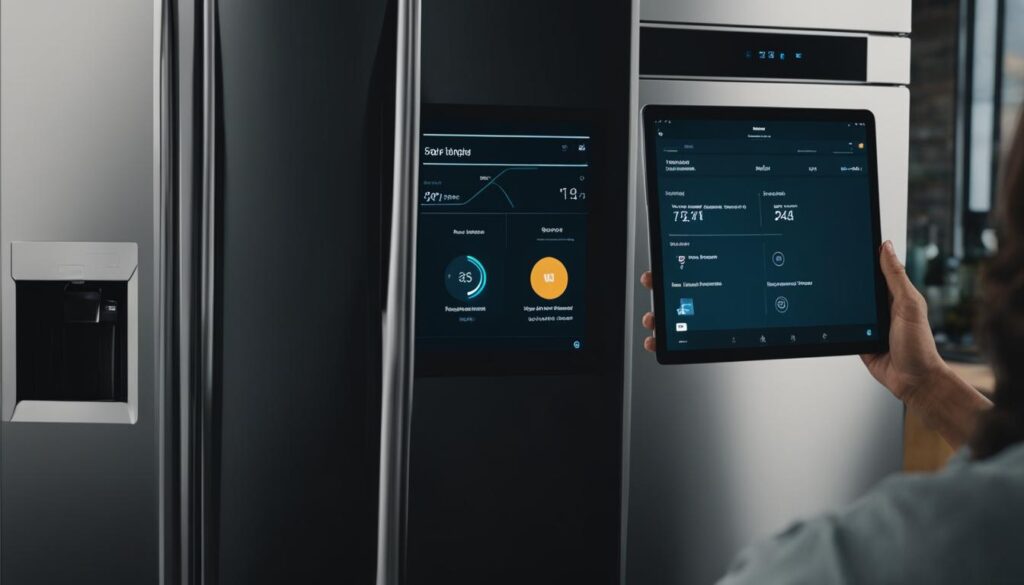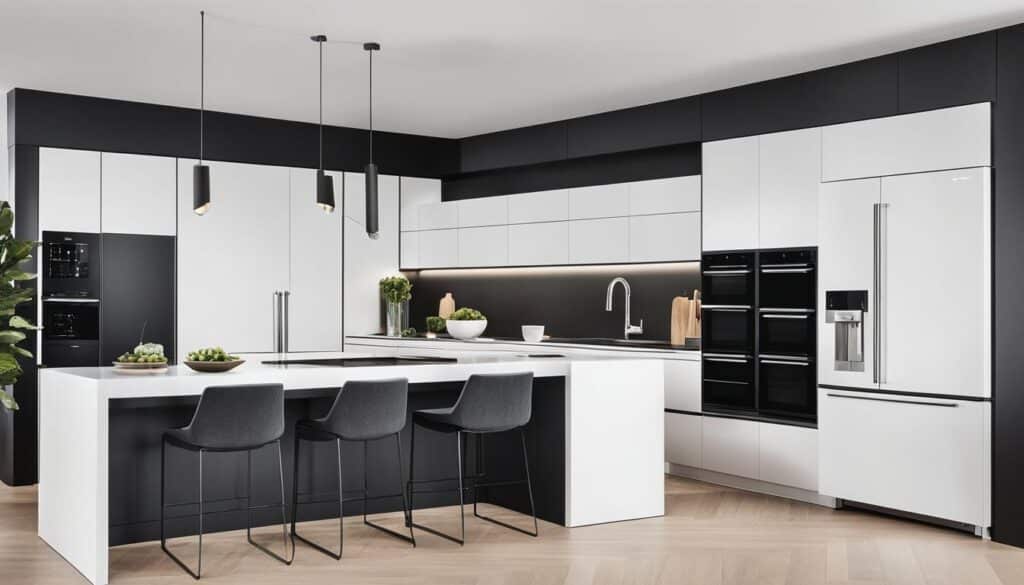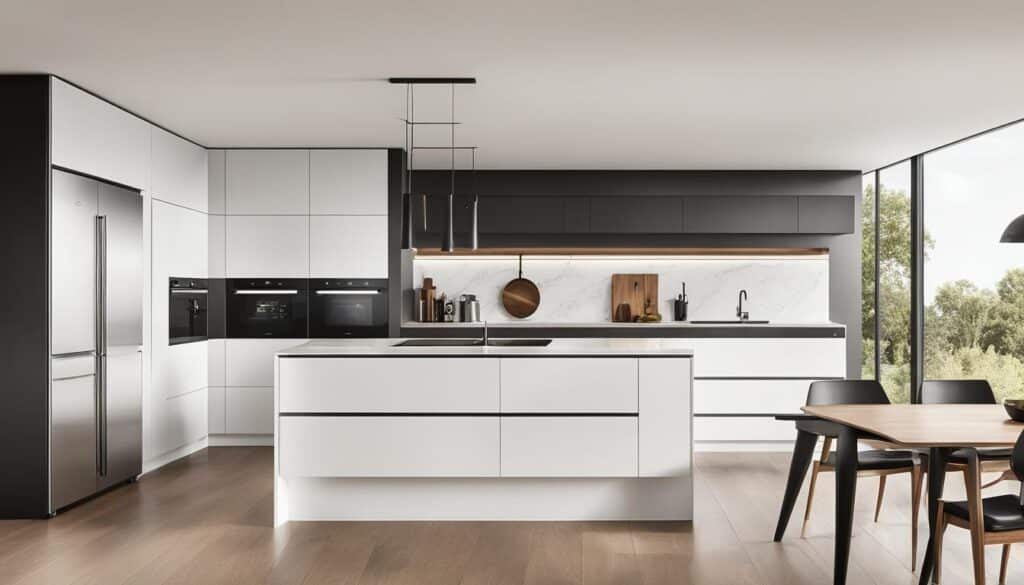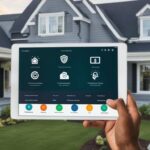Gone are the days when appliances were simple tools that served a single purpose. With the rise of smart home technology, integrating smart appliances into your home opens up a world of possibilities and convenience. Whether you’re a beginner or new to smart home technology, this guide will provide you with the information you need to successfully integrate smart appliances into your home.
Table of Contents
Key Takeaways:
- Integrating smart appliances can elevate your home tech game and make everyday tasks more convenient.
- Smart appliances offer benefits such as task automation, energy efficiency, enhanced home security, and remote access and control.
- Consider factors like compatibility, functionality, and budget when choosing the right smart appliances for your home.
- Setting up smart appliances involves connecting them to your home’s Wi-Fi network and installing companion apps on your smartphone or tablet.
- Integrate your smart appliances with popular voice assistants for hands-free control.
Benefits of Smart Appliances
Smart appliances offer a multitude of benefits for homeowners, revolutionizing the way we interact with our homes and enhancing our daily lives. The integration of smart appliances into our homes brings a plethora of advantages, making our lives easier and more convenient.
Automation and Convenience
One of the key benefits of smart appliances is their ability to automate various tasks, saving us time and effort. Imagine waking up to the aroma of freshly brewed coffee as your smart coffee maker starts brewing as soon as your alarm goes off. With smart appliances, you can automate tasks such as turning on the washing machine, adjusting the thermostat, or starting the dishwasher, allowing you to focus on more important things.
Energy Efficiency
Smart appliances are designed with energy efficiency in mind, helping you reduce your carbon footprint and save on energy bills. These appliances utilize advanced technology to optimize their energy usage, ensuring that they operate at maximum efficiency. For example, smart thermostats can learn your schedule and adjust the temperature accordingly, minimizing unnecessary energy consumption.
Enhanced Home Security
Integrating smart appliances into your home can significantly enhance your home security. Smart security systems, such as smart door locks, cameras, and motion sensors, provide you with peace of mind by allowing you to monitor and control your home remotely. Receive instant notifications on your smartphone when a door is unlocked or motion is detected, and even view a live feed of your home’s surroundings, all with the touch of a button.
Remote Access and Control
With smart appliances, you can have control of your home from anywhere in the world. Forgot to turn off the lights? No problem. Simply open the companion app on your smartphone and switch them off remotely. Want to preheat the oven for dinner while you’re still at work? Easy. Smart appliances enable you to streamline your daily routines and ensure that your home is always optimized for your needs.
Improved Functionality
Smart appliances offer advanced features and functionalities that enhance our overall home experience. From voice control compatibility with popular virtual assistants like Amazon Alexa or Google Assistant to personalized settings and preferences, these appliances cater to our individual needs, making our lives more comfortable and enjoyable.
By integrating smart appliances into your home, you can truly experience the benefits of smart home technology. Whether it’s automating tasks, increasing home security, or enjoying energy efficiency, smart appliances are revolutionizing the way we live. Embrace the future of home living and discover the endless possibilities that smart appliances have to offer.
| Benefits of Smart Appliances |
|---|
| Automation and Convenience |
| Energy Efficiency |
| Enhanced Home Security |
| Remote Access and Control |
| Improved Functionality |
Choosing the Right Smart Appliances
When it comes to choosing smart appliances for your home, there are a few key considerations to keep in mind. By taking the time to research and evaluate different options, you can ensure that you select appliances that align with your specific needs and preferences.
Compatibility: It’s important to choose smart appliances that are compatible with your existing smart home ecosystem. Check whether the appliances work seamlessly with the smart hub or voice assistant you currently use, such as Amazon Alexa or Google Assistant. This compatibility ensures that all your devices can communicate with each other and perform coordinated actions.
Functionality: Evaluate the functionality of the smart appliances you’re considering. Think about the tasks you want them to perform and the features you need. For example, if you’re looking for a smart refrigerator, consider whether you want it to have features like temperature control, inventory management, or compatibility with grocery delivery services.
Budget: Set a budget for your smart appliances and stick to it. Determine how much you’re willing to invest and prioritize the features that are most important to you. Keep in mind that prices can vary based on brand, model, and functionality. Consider the long-term cost savings that energy-efficient appliances can provide.
Reading reviews and comparing different brands and models can also help you make an informed decision. Look for reviews from reputable sources and take note of any common issues or concerns mentioned by users.
“Choosing the right smart appliances for your home requires careful consideration of factors such as compatibility, functionality, and budget.” – Smart Home Living
Table: Smart Appliance Comparison
| Appliance | Brand | Compatibility | Functionality | Price |
|---|---|---|---|---|
| Smart Refrigerator | Samsung | Works with SmartThings | Temperature control, inventory management | $2,000 |
| Smart Oven | Whirlpool | Works with Google Assistant | Remote control, recipe suggestions | $1,500 |
| Smart Washer | LG | Works with Amazon Alexa | Remote start, energy usage tracking | $1,200 |
By considering compatibility, functionality, and budget, you can confidently choose the right smart appliances for your home. Take the time to research and compare options to ensure that the appliances you select enhance your daily life and seamlessly integrate into your smart home ecosystem.
Setting Up Your Smart Appliances
Setting up your smart appliances is an essential step in bringing the convenience of smart home technology into your daily life. By connecting your appliances to your home’s Wi-Fi network and installing the necessary companion apps, you’ll unlock a world of possibilities. While each appliance may have a slightly different setup process, the general steps are straightforward and easy to follow.
Connect to your Wi-Fi network: To begin the setup process, ensure that your smart appliance is within range of your home’s Wi-Fi network. Access the settings menu on the appliance and select the Wi-Fi option. From there, you’ll be prompted to select your network and enter the password. Once connected, the appliance will have internet access and can communicate with your other smart devices.
Install the companion app: Most smart appliances require a companion app on your smartphone or tablet for full control and customization. Search for the app in your device’s app store and download it. Follow the instructions provided by the manufacturer to create an account and link the app to your smart appliance. This app will serve as your central hub for monitoring and controlling your appliance.
Follow the manufacturer’s instructions: Each smart appliance will have specific instructions for completing the setup process. It’s essential to carefully read and follow these instructions to ensure a successful setup. The manufacturer’s instructions will provide guidance on any additional steps, such as firmware updates or pairing with other devices.
Once you’ve completed the setup process, your smart appliance will be seamlessly integrated into your smart home network. You’ll have the ability to control and monitor your appliance remotely, set schedules or timers, and even receive notifications and alerts.
“Setting up my smart appliances was a breeze. The step-by-step instructions provided by the manufacturers made the process simple and straightforward. Now I can control my appliances from anywhere, whether I’m at home or on the go!”
With your smart appliances connected and ready to use, you can start enjoying the convenience and efficiency they bring to your everyday life.
Smart Appliance Setup Tips:
- Set up your smart appliances one at a time to avoid any confusion or errors.
- Make sure your home’s Wi-Fi network has a strong signal in the area where your smart appliances will be placed.
- Keep your Wi-Fi network password handy during the setup process.
- Regularly check for firmware updates for your smart appliances to ensure you have the latest features and security patches.
By following these tips and the manufacturer’s instructions, you’ll have your smart appliances up and running in no time, creating a more convenient and connected home.
| Advantages of Setting Up Smart Appliances | Benefits |
|---|---|
| Convenience | Control your appliances from anywhere, anytime. |
| Energy Efficiency | Save energy by scheduling and automating your appliance’s operation. |
| Customization | Set personalized preferences and create routines tailored to your needs. |
| Remote Monitoring | Receive alerts and notifications for increased peace of mind. |

Integrating Smart Appliances with Voice Assistants
One of the key benefits of smart appliances is the ability to control them with voice commands through popular voice assistants like Amazon Alexa or Google Assistant. By integrating your smart appliances with a voice assistant, you can control them with simple voice commands, making your home even more convenient and hands-free.
Imagine being able to turn on your coffee maker or adjust the temperature of your smart thermostat without lifting a finger. With voice control, you have the power to command your appliances from anywhere in your home, whether you’re cooking in the kitchen or relaxing on the couch.
Integrating smart appliances with voice assistants not only adds convenience but also enhances the accessibility of your home. Voice commands allow for a more intuitive and natural way of interacting with your appliances, removing the need for cumbersome buttons or switches.
Whether you want to dim the lights, play your favorite music, or start your robotic vacuum cleaner, voice assistants can simplify your daily routines and save you valuable time and effort.
“Hey Google, preheat the oven to 350 degrees.”
With just a simple voice command, you can have your oven ready for baking without any manual input. The integration of voice assistants with smart appliances brings a new level of convenience and efficiency to your home.
Additionally, voice assistants often offer a range of other features that can complement your smart appliances. From answering your questions and providing weather updates to controlling other smart devices in your home, voice assistants become the central hub for managing your smart home ecosystem.
Compatibility and Setup
Before integrating your smart appliances with voice assistants, ensure that they are compatible with the voice assistant platform you intend to use. Most reputable smart appliance brands provide compatibility information on their websites or packaging.
Setting up the integration between your smart appliances and voice assistants typically involves linking the devices through their respective companion apps. The process may vary slightly depending on the brand and model of your appliances, but generally, you’ll follow the manufacturer’s instructions to connect them to your voice assistant.
Once connected, you can start controlling your smart appliances with voice commands. Remember to familiarize yourself with the available voice commands for each appliance, as different functionalities may require specific phrasing or keywords.
| Smart Appliance Voice Commands | Functionality |
|---|---|
| “Alexa, start the dishwasher.” | Control the start or stop function of the dishwasher |
| “Hey Google, turn on the air purifier.” | Activate or deactivate the air purifier |
| “Alexa, set the thermostat to 72 degrees.” | Adjust the temperature of your smart thermostat |
Above are just a few examples of how you can leverage voice assistants to control your smart appliances. Experiment with different commands and explore the full capabilities of your voice assistant and connected devices.

Integrating smart appliances with voice assistants brings a new level of convenience, control, and automation to your smart home. With a simple voice command, you can transform your living space into an efficient and hands-free environment. Start exploring the possibilities of voice control today and unlock the full potential of your smart appliances.
Creating Automations and Scenes
Once you have your smart appliances set up and connected, you can unlock the full potential of your smart home by creating automations and scenes. These features allow you to automate tasks and control multiple devices with ease, bringing convenience and efficiency to your daily routine.
Automations
Automations are a powerful tool that lets you set up smart home devices to perform certain actions automatically based on triggers. Whether it’s adjusting the lighting when you enter a room, playing your favorite playlist as you walk through the door, or turning off all devices at bedtime, automations make your home more intelligent and responsive.
With smart home automations, you can:
- Save time: Automating repetitive tasks eliminates the need for manual intervention, giving you more time for things that matter.
- Enhance energy efficiency: Set your appliances to turn off when not in use or adjust thermostat settings based on occupancy, reducing your energy consumption.
- Improve comfort: Set your home to the perfect temperature, brightness, and ambiance before you even step through the front door.
Scenes
Scenes take automation a step further by allowing you to control multiple smart devices simultaneously with a single command or button press. Instead of adjusting each device individually, you can activate a pre-defined scene to create the perfect environment for a specific activity or mood.
For example, imagine saying, “Hey Google, activate Movie Night,” and your lights dim, blinds close, and your TV and soundbar power on, creating a cinema-like experience in your living room. Scenes not only simplify control but also provide a seamless and immersive smart home experience.
Here’s an example of popular scenes:
| Scene | Description |
|---|---|
| Good Morning | Turns on lights, adjusts thermostat, and plays your favorite morning playlist to wake you up gently. |
| Leaving Home | Turns off all lights, locks doors, and adjusts temperature settings to conserve energy while you’re away. |
| Party Time | Creates a festive atmosphere by activating colored lights and playing upbeat music throughout your home. |
Creating scenes is easy with the companion apps provided by your smart home devices. Simply determine which devices should be included in each scene and customize the settings accordingly. With just a few taps, you’ll have the power to transform your living space with scene control.
With the ability to create automations and scenes, your smart home will work in harmony to simplify your life and create personalized experiences. From automating everyday tasks to setting the mood for any occasion, smart home technology gives you unprecedented control and convenience at your fingertips.
Enhancing Home Security with Smart Appliances
Integrating smart security devices into your home can provide an extra layer of protection and peace of mind. By combining the power of smart appliances with advanced security features, you can monitor and safeguard your home remotely. Imagine receiving real-time notifications on your smartphone, having the ability to view live or recorded footage, and knowing that your home is secure even when you’re not there.
Smart security devices such as cameras, door locks, and motion sensors play a crucial role in enhancing home security. These devices are designed to detect and deter potential intruders, giving you the upper hand in protecting your property. Whether you’re at work, on vacation, or simply away from home, these smart appliances work tirelessly to keep your home and loved ones safe.
One of the key advantages of integrating smart security devices is the ability to monitor your property remotely. With just a few taps on your smartphone, you can access live or recorded footage from your security cameras, allowing you to keep an eye on your home from anywhere in the world. This level of visibility provides reassurance and allows you to respond promptly to any suspicious activity.
In addition to visual monitoring, smart security devices can also send real-time notifications to your smartphone in the event of any unusual occurrences. Whether it’s a door left unlocked or unexpected activity detected by a motion sensor, you’ll be instantly alerted, ensuring that you can take appropriate action in a timely manner.
Another benefit of integrating security devices into your smart home ecosystem is the ability to create custom automations and scenes. For example, you can set up an automation that turns on the outdoor lights and triggers the security cameras to start recording as soon as motion is detected. This not only provides increased security but also acts as a deterrent to would-be intruders.
By integrating smart security devices into your home, you can enjoy an enhanced level of control and convenience. For instance, imagine being able to lock or unlock your doors remotely, grant access to guests or service providers even when you’re not present, or receive alerts if a door or window is opened while the security system is armed. These features empower you to manage and monitor your home security with ease.
Key Features of Smart Security Devices
| Device Type | Key Features |
|---|---|
| Security Cameras |
|
| Smart Door Locks |
|
| Motion Sensors |
|
With the various smart security devices available in the market, it’s important to choose those that align with your specific needs and preferences. Consider factors such as compatibility with your existing smart home ecosystem, ease of installation, and the specific features that matter most to you. Remember, investing in smart security devices is an investment in the safety and security of your home.
By integrating smart security devices into your home, you can enjoy the benefits of advanced home security technology, giving you greater control, convenience, and peace of mind. Create a connected and secure smart home that protects what matters most to you.
Conclusion
Integrating smart appliances into your home is a game-changer for your home technology and everyday convenience. By following this beginner’s guide, you’ll gain the knowledge and confidence needed to successfully integrate and enjoy the benefits of smart appliances.
With smart appliances, you can automate tasks, enjoy energy efficiency, enhance home security, and have remote access and control. These appliances offer a new level of convenience and efficiency, transforming your home into a smart haven.
Start your smart home journey today and experience the future of home living. By choosing the right smart appliances, setting them up correctly, integrating them with voice assistants, and creating automations and scenes, you’ll unlock the full potential of your smart home technology.
FAQ
What are the benefits of integrating smart appliances into my home?
Integrating smart appliances into your home offers automation, energy efficiency, enhanced home security, and remote access and control.
What factors should I consider when choosing smart appliances for my home?
When choosing smart appliances, factors to consider include compatibility with your existing smart home ecosystem, functionality, and budget. Additionally, research different brands and models, read reviews, and determine which appliances best suit your needs and preferences.
How do I set up my smart appliances?
To set up your smart appliances, you’ll need to connect them to your home’s Wi-Fi network and install any necessary companion apps on your smartphone or tablet. Follow the manufacturer’s instructions to connect the appliance to your smart home network.
Can I control my smart appliances with voice commands?
Yes, you can control your smart appliances with voice commands by integrating them with popular voice assistants like Amazon Alexa or Google Assistant. This allows you to control your appliances with simple voice commands, making your home even more convenient and hands-free.
How can I further streamline my smart home experience?
You can create automations and scenes to further streamline your smart home experience. Automations allow you to set certain actions to occur automatically based on triggers like time of day or specific events. Scenes allow you to control multiple smart devices at once with a single command or button press.
Can smart appliances enhance my home security?
Yes, integrating smart security devices like cameras, door locks, and motion sensors can enhance your home security. You can monitor and protect your home remotely, receive real-time notifications on your smartphone, and view live or recorded footage for greater peace of mind.
How can I get started with integrating smart appliances into my home?
By following this guide, you’ll have the knowledge and confidence to successfully integrate smart appliances into your home. Start by researching and choosing the right appliances for your needs, then set them up and explore the various features and benefits they offer.


